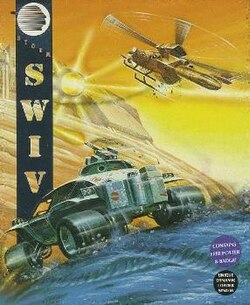This article needs additional citations for verification .(December 2022) |
| SWIV | |
|---|---|
 | |
| Developer(s) | The Sales Curve |
| Publisher(s) | Storm |
| Platform(s) | Amiga, Atari ST, Acorn Archimedes, ZX Spectrum, Amstrad CPC, Commodore 64, MSX, Game Boy Color |
| Release | 1991 |
| Genre(s) | Scrolling shooter |
| Mode(s) | Single-player, multiplayer |
SWIV is a 1991 vertically scrolling shooter video game developed and published by The Sales Curve. It was released for the Amiga, Atari ST, Commodore 64, MSX, ZX Spectrum, and Amstrad CPC computers. A Game Boy Color conversion was published in 2001.
Contents
The game was considered a spiritual successor to Tecmo's arcade game Silkworm , which The Sales Curve had previously converted to home computer formats in 1989. The game's heritage is evident from the game design whereby one player pilots a helicopter, and the other an armoured Jeep. SWIV is not an official sequel, as noted by ex-Sales Curve producer Dan Marchant: "SWIV wasn't really a sequel to Silkworm, but it was certainly inspired by it and several other shoot-'em-ups that we had played and loved." [1]
According to the game's manual, "SWIV" was an acronym for "Special Weapons Interdiction Vehicle" and also short for "Silkworm IV", a lethal homing missile used by enemy units. [2]